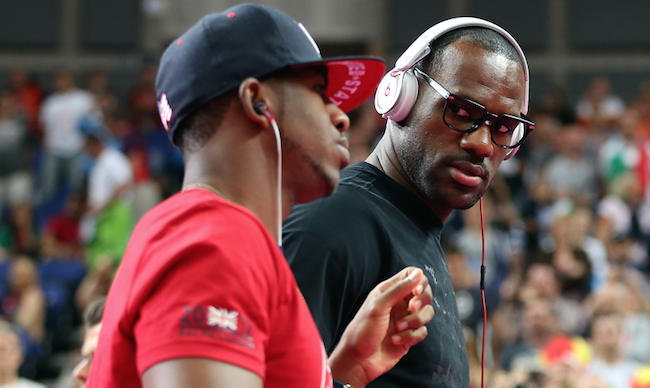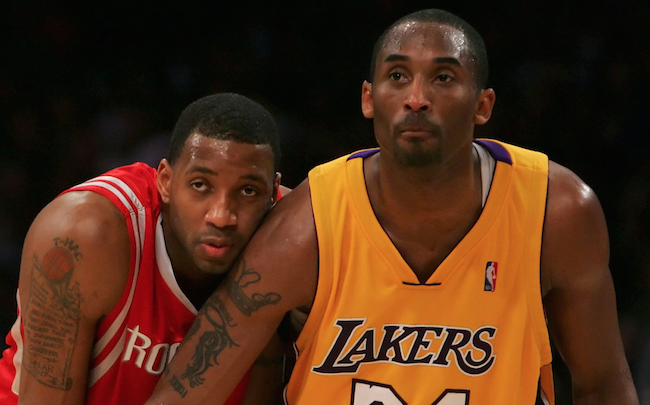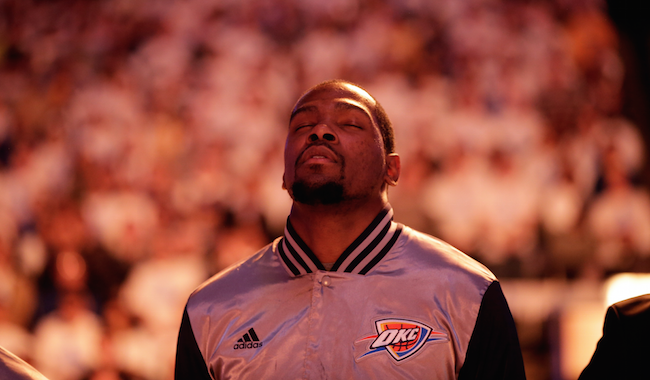It doesn’t seem possible, does it? It’s been four years since the 2011 lockout whittled an NBA season to 66 games, and in the process squandered so much of the goodwill the league had amassed over the previous decade. When the Players’ Union and the owners finally struck a deal on a new collective bargaining agreement (CBA), 2017 seemed so far away.
But here we are, once again staring down the barrel of another possible work stoppage if the two sides can’t come to terms before the current CBA expires in two years. If new NBPA Executive Director Michele Roberts has anything to say about it, negotiations will never get that far. At least that’s what she told the Italian media outlet Sportando in a recent interview:
“Sitting down at a table already now with the NBA to understand what worries the owners and what worries the players. In the past very few attempts to speak in advance of the problems that led to the lockouts have been made. Whether both commissioner Silver and myself want to do everything possible to prevent the NBA to stop: the only way is to negotiate. We have already started, we will meet again in early September with the hope to announce within the end of the season that the union and the league have solved their problems.”
If that sounds like extremely wishful thinking to you, then you’re not alone. The first problem with that plan is that both sides have until the end of next year (Dec. 15, 2016) to opt out of the current CBA, and it seems highly unlikely that they’ll try to fast-track any sort of agreement in the middle of an NBA season.
The good news is that the union has regained its credibility under Roberts and has significantly more political clout with Chris Paul and LeBron James acting as its new president and vice president, respectively. The NBPA was wracked by scandal under the previous director, Billy Hunter, who was unanimously ousted in 2013 amid accusations of nepotism and financial mismanagement. Under Roberts’ new leadership, though, the players have a savvy trial lawyer with Capitol Hill experience and, perhaps most importantly, a sober understanding of the NBA’s current economic climate.
Roberts went on to say that there are approximately 10 items the union would like to re-evaluate for the next CBA, and if that proves to be the case, she’ll be opening up a can of worms. Here’s what commissioner Adam Silver had to say about the prospect of opting out of the current CBA in an interview with Bleacher Report’s Howard Beck in May:
“As you guys know…there were a lot of things we left on the table, as well [in 2011]. We went into collective bargaining seeking—I don’t want to get into it now—but a number of things that we didn’t accomplish. And we compromised. And they compromised as well.
“If there’s a feeling that we should reopen the collective bargaining agreement, there will be things that we’re going to bring back to the table, too.”
So, what exactly is at stake for both sides? Several things, actually, and it’s all very Byzantine in terms of its complexity, but as you’ve probably surmised, it all circles back to dollars and cents.

Revenue Sharing
You’ve heard this a million times by now, but the NBA is bracing itself for an unprecedented influx of revenue from the massive television deals it signed last year (approximately $24 billion over nine years), which will effectively transform the new collective bargaining agreement into a giant cash grab.
It’s a nice problem to have, but what’s ultimately unavoidable in this equation is all the accusations and recriminations that will inevitably accompany any debate about how to divide the money between the league, the owners, and the players. In 2011, a vast majority of the owners cried poverty and claimed that their franchises were operating at a loss, which was a hard pill to swallow then and will be even harder to accept now given the unequivocal financial health and growth of the league.
The union eventually caved to owners’ demands on the distribution of basketball-related income (BRI), slicing their share of the pie from 57 percent to 50 percent. The players will be loathe to make any further concessions in this area, but that doesn’t mean the owners won’t try to force their hand. At an NBA Board of Governors meeting in July, Silver claimed that nearly a third of NBA franchises are currently operating at a loss, a strong indication that the owners are already busy digging their trenches.
Close to 10 NBA teams are amongst the losing $ category that Adam Silver spoke of, source said. But how many teams have themselves to blame?
— Marc J. Spears (@MarcJSpears) July 16, 2015
League owners are currently set to write the union a $500 million shortfall check in order to meet the agreed upon 50 percent of the revenue. It’s a direct result of the limits placed on players’ earning potential as defined by the current league-wide salary cap and max contracts, and the revenue the owners received in excess of their own fiscal projections. The owners, of course, don’t want to write that check, and when negotiations start to ramp up again, you can bet they’ll want to reduce the players’ share of the revenue even lower in order to account for that. But the players will have different ideas, such as eliminating max contracts altogether and establishing a truly open market. (See the salary cap section below for more.)

The Age Limit
All sorts of agreements were built into the last CBA, not the least of which was the minimum age requirement for players to be eligible to enter the league. The league raised it to 19 years old in 2006 after a long succession of prep-to-pros busts made the status quo untenable in the eyes of many. The idea was that raising the age limit to 19 would force prospective draftees to attend at least one year of college, although in recent years some have circumvented that rule by spending a year playing professionally overseas.
When Silver took over 18 months ago, he made it clear that raising the age limit to 20 was one of his top priorities. But it seems increasingly likely that the Players’ Union will, in fact, seek to reset the age limit to 18 or, at the very least, keep it at 19. This could be a major sticking point in the new CBA as the union seeks a comprehensive overhaul on various topics pertaining to earning potential (again, more on that below). Here’s what the NBPA’s general counsel, Gary Kohlman, had to say on the matter back in March. Via Tim Reynolds of the Associated Press:
“If they were white and hockey players they would be out there playing. If they were white and baseball players they would be out there playing,” Kohlman said. “Because most of them are actually African-American and are in a sport and precluded from doing it, they have to go into this absurd world of playing for one year.
“That’s just total complete hypocrisy.”
Yikes.
If the Players’ Union does indeed want to invoke the racial overtones of this debate, things could get ugly fast. You’ll recall that the 2011 lockout was not without its extremely misguided and very poorly-conceived analogies to slavery, so Roberts and the union will have to effectively dial down the rhetoric if they want to avoid another P.R. disaster and not compound the collective ire they will inevitably draw from basketball fans everywhere.

The Salary Cap
If you thought the spending was out of control this summer in free agency, just wait until the salary cap skyrockets toward the $90 million threshold. Part of the reason for this is that the union recently rejected a proposal from the league for a so-called “smoothing” of the cap which would have spread out the incoming money from the TV deal gradually over the next few years. Instead, the players will reap the benefits of the almost $2.6 billion per year coming in.
The record spending this summer was in anticipation of precisely that. The massive contracts doled out to what would once be considered mid-level players will look like bargain-basement deals over the next two years. Likewise, the top free agents in 2016 – e.g. LeBron, Kevin Durant – could command between $30 and $40 million per year, depending on the length of the contract.
But there’s another bold idea that has been floating around the past few years that could potentially come up in this new round of negotiations: the end of max contracts.
The NBA is emphatically not a democracy. On the contrary, it’s practically Marxist in its philosophy of distribution of wealth for the greater good. Both sides would prefer a more democratic system, or at least one that would work to their respective advantage.
Let’s set aside for a moment all the (perfectly reasonable) moral and ethical qualms you might have about the lack of oversight in our American capitalist system that led directly to the recession that very nearly crippled our financial institutions. Let’s imagine for a moment a league in which there was no limit to the dollar amount an individual player could earn. What would that look like?
Well, for starters, superstar players would finally earn what they believe they’re worth on a truly open market (or at least the upper-echelon of what owners would be willing to pay them). But there’s a few drawbacks to this system that should cause considerable pause.
First, it could mean the end of super teams. Let’s use James as an example, and let’s say that when (not if) he opts out of his current two-year contract next summer that the Cavs sign him to a deal somewhere in the neighborhood of $200 million over six years.
Even before Tristan Thompson’s contract gets factored in, Cleveland was already well above the $90 million cap for next year. But we’re talking about the Cavs here, and the Cavs, of course, have to do whatever they have to do to keep LeBron happy, and that’s meant a max deal for both Love and Thompson. It also put the onus on the organization to pay the luxury tax and likely the repeater tax the year after that.
Most franchises outside of Cleveland will be less likely to assume such an undertaking. They’ll also be far less likely to convince superstar players to absorb a pay cut in order to form a super-team, the way LeBron and others have done in the past. That’s because instead of taking a couple of million less per year, they’d have to take pay cuts approaching the eight-figure mark or higher to make the numbers work, a financial burden that’s a lot harder to stomach.
It would also ideally help restore the competitive balance around the league as smaller market teams would ostensibly have a fairer shot at luring big-name players.
Mavs owner Mark Cuban told Jeff Caplan of NBA.com last fall that he and other owners would be willing to listen to the idea of eliminating max deals during this next round of negotiations, but not without a significant compromise on the part of the players:
“If you give up guarantees,” Cuban said. “It’s a trade-off.”
What Cuban is alluding to is the substantial risk involved (i.e. catastrophic injury, stasis, regression) in signing a player to a fully guaranteed contract. As it stands under the current CBA, teams are permitted only a single amnesty provision to help mitigate such situations, and even then, the team still has to pay said player, although the clause offers them salary cap and/or luxury tax relief.
There’s a host of other issues that are likely to be resurrected during negotiations, some of which, believe it or not, are somehow even wonkier in terms of their nuances… rookie-scale contracts, duration of extensions, a shortened season (unlikely given the advertising revenue), potential changes to Bird rights, as well as the biannual and mid-level exceptions, team and player options on contracts, and more.
Although it looks more and more likely that one or both parties will choose to opt out of the current CBA prior to next year’s deadline, that doesn’t mean another work stoppage is a foregone conclusion. Silver and Roberts both claim that they’ve deliberately nurtured a more-than-amicable professional relationship in hopes of avoiding that scenario altogether. For the league’s sake, let’s hope they can accomplished their shared goal.
(via Sportando; NBA.com; Associated Press; B/R)






